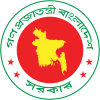Moulvibazar Sadar Upazila
Moulvibazar Sadar
মৌলভীবাজার সদর | |
|---|---|
 Moulvibazar Government High School | |
 | |
| Country | |
| Division | Sylhet |
| District | Moulvibazar |
| Headquarters | Moulvibazar |
| Government | |
| • MP (Moulvibazar-3) | Mohammad Zillur Rahman (Awami League) |
| • Upazila Chairman | Md Kamal Hossain (Awami League) |
| Area | |
| • Total | 344.32 km2 (132.94 sq mi) |
| Population | |
| • Total | 342,468 |
| • Density | 990/km2 (2,600/sq mi) |
| Demonym | Moulvibazari |
| Time zone | UTC+6 (BST) |
| Postal code | 3200 |
| Website | moulvibazarsadar |
Moulvibazar Sadar (Bengali: মৌলভীবাজার সদর) is an upazila of Moulvibazar District[1] in the Division of Sylhet, Bangladesh.
History[edit]

Moulvibazar was founded as a thana in 1882,[1] centred around an expanding bazaar (marketplace) founded by Moulvi Syed Qudratullah back in 1771.[2][3][4] In 1912, an anti-British protest was held in the village of Jagatshi, organised by Swami Dayananda. The anti-British Khilafat Movement in 1921 also spread to Moulvibazar and campaigners that were present included Congress leaders Chittaranjan Das, Hussain Ahmed Madani and Sarojini Naidu. In 1932, the Ali Amzad Government Girls' High School was opened as a public school.
During the Bangladesh Liberation War, armed resistance begun at the village of Srirainagar in Kanakpur on 27 March 1971. The Pakistani army was said to have made a surprise attack on the procession there in which two people were killed. The Naria massacre took place on 5 May in Upper Kagabala. On 20 December, a number of people were killed and wounded by mine explosions at the premises of the Moulvibazar Government High School. The status of the thana was upgraded to an upazila in 1984. In 2005, the Saifur Rahman Stadium was established, acting as a multi-use arena fitting 15,000 people.
Geography[edit]
Moulvibazar Sadar is located at 24°28′40″N 91°46′00″E / 24.4778°N 91.7667°E. It has 62,881 households and total area 344.32 km2. It is bordered by Balaganj in the north, Rajnagar and Kamalganj in the east, Srimangal in the south and Nabiganj in the west.
Administration[edit]

Moulvibazar Sadar Upazila is divided into Moulvibazar Municipality and 12 union parishads: Akhailkura, Amtail, Chandnighat, Ekatuna, Giasnagar, Kamalpur, Kanakpur Union, Khalilpur, Monumukh, Mostafapur Union, Nazirabad, and Uparkagabala. The union parishads are subdivided into 196 mauzas and 429 villages.[5]
Moulvibazar Municipality is subdivided into 9 wards and 48 mahallas.[5]
Demographics[edit]
According to the 2011 Bangladesh census, Moulvibazar Sadar Upazila had 62,881 households and a population of 342,468. 81,963 (23.93%) of the inhabitants were under 10 years of age. Moulvibazar Sadar had a literacy rate (age 7 and over) of 54.93%, compared to the national average of 51.8%, and a sex ratio of 995 females per 1000 males. 56,537 (16.51%) lived in urban areas.[5] Ethnic population was 1,613 (0.47%), of which Manipuri were 1,071.[6]
At the 1991 census, Moulvibazar Sadar had a population of 239,378. It has now grown to 281,593 according to later censuses. Males constitute 51.56% of the population, and females 48.44%. Its over-18 population is 126,303. Most of the people are Muslims. There are over 45,000 Hindus, 150 Christians, 17 Buddhists and 319 of other faiths.[1]
Education[edit]
According to Banglapedia, Ali Amzad Government Girls' High School, founded in 1932, is a notable secondary school. Moulvibazar Sadar has an average literacy rate of 48.6%.[7] The literacy rate for the urban areas is 65.2% while in the rural areas it is 45.7%.[1] The Upazila has 5 colleges as well as vocational, primary teacher, nurse, youth, blind welfare training institutes. It also has a co-operative institute, a horticulture research institute. There are 17 primary schools and 7 community and satellite schools, in addition to 16 kindergartens. In total, there are 42 madrasas.
Notable people[edit]
- Bajloor Rashid MBE, businessman and former president of the Bangladesh Caterers Association UK.[8][9]
- Saifur Rahman, longest serving Finance Minister of Bangladesh.[10]
- Syed Abdul Majid CIE, first native minister of Assam, pioneer of the agricultural industry
- Syed Qudratullah, founder of Moulvibazar
- Rangalal Sen, National Professor of Bangladesh.
- Syed Mohsin Ali, Former Member of the Jatiya Sangsad from Moulvibazar-3, Former Bangladesh Minister of Social Welfare and former President of Moulvibazar District Unit of Awami League.
- Hosne Ara Wahid, Member of Parliament, lived in Moulvibazar.[11]
See also[edit]
References[edit]
- ^ a b c d Shah Abdul Wadud (2012). "Maulvibazar Sadar Upazila". In Sirajul Islam; Miah, Sajahan; Khanam, Mahfuza; Ahmed, Sabbir (eds.). Banglapedia: the National Encyclopedia of Bangladesh (Online ed.). Dhaka, Bangladesh: Banglapedia Trust, Asiatic Society of Bangladesh. ISBN 984-32-0576-6. OCLC 52727562. OL 30677644M. Retrieved 25 April 2024.
- ^ "Itihash". Government of Bangladesh. Retrieved 24 September 2018.
- ^ ইসলামী বিশ্বকোষ [ISLAMI BISHWAKOSH: The Encyclopedia of Islam in Bengali, 21st Volume] (in Bengali). Dhaka, Bangladesh: Islamic Foundation, Bangladesh. September 1996. pp. 448–452. Archived from the original on 11 February 2016.
- ^ "Introduction". Moulvibazar.com. January 2016. Retrieved 4 September 2016.
- ^ a b c d "Bangladesh Population and Housing Census 2011 Zila Report – Maulvibazar" (PDF). bbs.gov.bd. Bangladesh Bureau of Statistics.
- ^ "Community Tables: Maulvibazar district" (PDF). bbs.gov.bd. Bangladesh Bureau of Statistics. 2011.
- ^ "Population Census Wing, BBS". Archived from the original on 27 March 2005. Retrieved 10 November 2006.
- ^ "Bangladeshi restaurant boss Bajloor Rashid made MBE". BBC News. 31 December 2011. Retrieved 1 June 2013.
- ^ "Honour for food industry captain". Kent: This Is Kent. 6 January 2013. Archived from the original on 7 July 2013. Retrieved 1 June 2013.
- ^ "Saifur Rahman's life sketch". The Daily Star. 5 September 2009. Archived from the original on 7 October 2012. Retrieved 14 April 2019.
- ^ মৌলভীবাজারের সাবেক এমপি হুসনে আরা ওয়াহিদ মারা গেছেন [Former Moulvibazar MP Hosne Ara Wahid has died]. Samakal (in Bengali). 6 April 2020.

